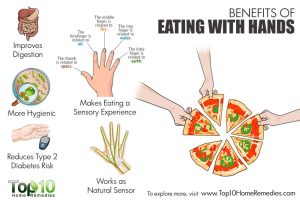Introduction
The act of eating with our hands is deeply ingrained in human history and culture. In this article, we’ll delve into the psychological aspects of hand-eating and explore how it can promote a healthier relationship with food. Supported by scientific research, we’ll uncover the connection between tactile dining and mindful consumption, shedding light on the benefits of this age-old practice.
The Eating Habit Challenge
In a world of fast food and mindless consumption, fostering positive eating habits is a modern challenge. Let’s explore how the practice of hand-eating can address this challenge.
The Tactile Experience
Before we dive into the specifics, let’s understand why the tactile experience of hand-eating matters.
1. Engaging the Senses
Eating with our hands engages multiple senses, enhancing our connection with the food and its flavors.
2. Mindful Consumption
The tactile experience encourages us to pay closer attention to our food, promoting mindful consumption.
3. Heritage and Tradition
In various cultures, hand-eating is a cherished tradition that connects individuals with their culinary heritage.

Scientific Insights
Now, let’s explore scientific research that supports the psychological benefits of hand-eating.
1. Mindful Eating
Studies have shown that the tactile experience of hand-eating can lead to more mindful consumption. By feeling the textures and temperatures of food, we become more attuned to our eating patterns.
2. Sensory Connection
The sensory aspects of hand-eating, such as the touch and smell of the food, create a stronger connection between the mind and the meal, enhancing our eating satisfaction.
3. Portion Control
Research indicates that individuals tend to eat more mindfully when consuming food with their hands, which can lead to better portion control and reduced overeating.
4. Reduced Stress Eating
Engaging with food through touch and taste can reduce stress eating by promoting a calmer and more mindful approach to meals.
5. Enhanced Flavor Perception
The tactile experience can enhance our perception of flavors, making the dining experience more enjoyable and satisfying.
Incorporating Hand-Eating
To make the most of the psychological benefits of hand-eating, it’s essential to know how to incorporate this practice into your dining routine.
1. Mindful Choices
Choose foods that are suitable for hand-eating, such as fresh fruits, vegetables, or certain types of bread.
2. Clean Hands
Maintain good hand hygiene to ensure that the tactile experience remains a positive one.
3. Appropriate Settings
Enjoy hand-eating in settings where it’s culturally accepted and where you can focus on the experience without distractions.
4. Share the Tradition
Introduce hand-eating to friends and family, sharing the psychological and cultural benefits of this practice.

Conclusion
The psychology of hand-eating is a fascinating exploration of how our tactile experience can promote positive eating habits. Supported by scientific research, this age-old practice encourages mindful consumption, enhances flavor perception, and fosters a healthier relationship with food.
This article is your gateway to understanding the psychological aspects of hand-eating and how you can incorporate it into your dining routine. Whether you’re savoring fresh fruits, enjoying a cultural hand-eating tradition, or simply seeking a more mindful approach to your meals, the tactile experience of hand-eating can lead to a healthier and more satisfying dining experience.












